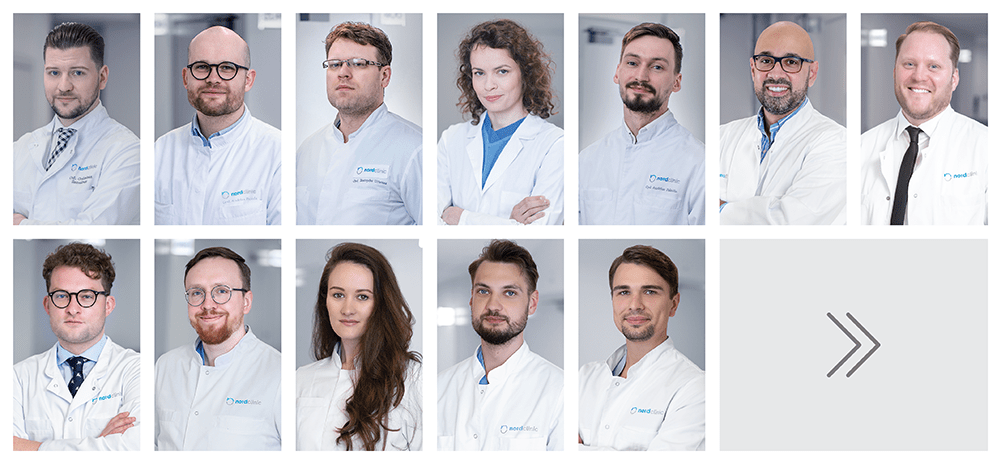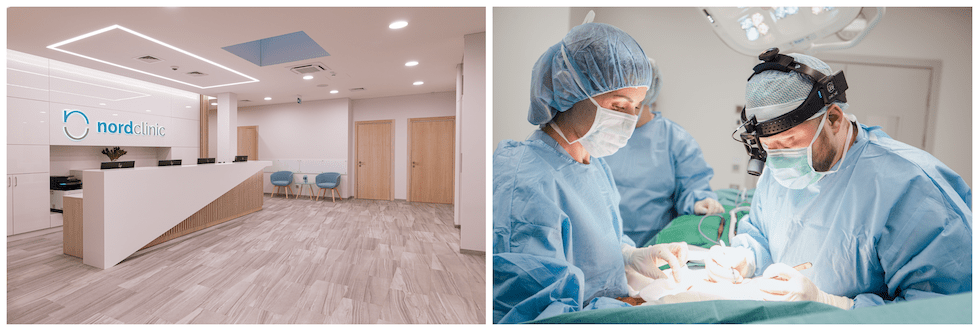Thigh Lift in Lithuania: Kaunas
Leading plastic surgery clinic
We are one of the leading plastic surgery clinics in the European Union with over 10 years of experience. Our team of 12 plastic surgeons performs more than 3.000 plastic operations a year. Around 90 % of our patients travel from abroad, mostly from the UK, Ireland, Norway, Sweden, Denmark, Germany.
See before-after pictures
Reviews & Facebook group
Prices
- thigh lift – 3.000 £ / 3.600 €
- thighs liposuction – 1.700 £ / 2.050 €
- thigh lift & arm lift – 4.575 £ / 5.490 €
- thigh lift & breast lift – 5.220 £ / 6.265 €
- thigh lift & tummy tuck – 5.260 £ / 6.310 €
- thigh lift & liposuction – 3.670 £ / 4.400 €
- mommy makeover: breast lift, implants, tummy tuck – 6.125 £ / 7.350 €
91% of our patients combine eyelid surgery with other procedures (read more in the next tab)
- additional aftercare: hyperbaric oxygen therapy, aftercare package in the UK and Ireland, accommodation with medical care
- additional procedures: gynecological, dermatology (including FREE consultation)
91% of our thigh lift surgery patients choose to combine it with other plastic surgeries.
Most popular combinations with thigh lift surgeries are:
- 32% liposuction
- 23% armlift
- 20% tummy tuck
- 20% breast surgeries (enlargement, lift, reduction)
- 13% buttock surgeries (buttock lift, brazilian buttock lift, buttock implants)
- 31% other surgeries
Our clinic has a unique experience in combining multiple plastic surgeries. It has been our specialisation for many years now and during this time we performed such surgeries for more than 10.000 patients. Combining surgeries allow our patients to save time, money and even health. When several surgeries are combined, discounts are available.
IMPORTANT: The exact combination always needs to be confirmed by the surgeon and the medical team who will evaluate the possible additional risks in the individual case. We carefully select patients, evaluate each case individually, and only agree to combine surgeries within health & safety limits.
- consultation with the surgeon
- necessary health tests
- surgery
- anaesthesia
- hospitalisation (1 night) with free Wi-Fi and Netflix
- a massage to help you recover quickly
- 24/7 personal assistance during your stay
- transfers to / from the airport, hotel and clinic
Please note that the price of the surgery itself is provisional and may be accurately assessed only after the evaluation of each individual case.
The default currency in our clinic is Euro, so if you were looking at prices in GBP it may vary depending on GBP / EUR exchange rate at the moment of payment.
All of our patients can use one of our offers available at the moment.
- Special 5-10% discount for booking in our last minute booking service for the next 30 days.
- Usually from 10% to 30% discount for combining multiple surgeries. Find more information in the “Combine to save” tab above.
- Additional services in our clinic. You or your accompanying persons can explore the various services by following this link. Customise your preferences and request to book any preferred procedures.
- Brand ambassador discount. If you have a community that would be interested in our services, you can now get a discount for your procedure by spreading the word about our clinic on your social media. Contact your customer service representative for more information.
Find more information about the available offers here.
- Informational meeting with plastic surgeons E.Virbickaite in LONDON on April 20-21 and A.Pakulis in DUBLIN on May 27-29.
- Alternatively, slots for online consultations with plastic surgeons are available!
Book your spot >>
Aftercare
Videos about our clinic
Find more videos of patients, surgeons and the clinic here.
Our patients and clinic in the media
12 reasons that make us the most popular plastic surgery clinic abroad
Even 68% of our patients travel to have combined surgeries due to our expertise in this field – it has been our specialisation for many years now. We performed such surgeries for more than 10.000 patients to this date. Combining surgeries allow our patients to save time, money and even health. We carefully select patients, evaluate each case individually, and only agree to combine surgeries within health & safety limits.
We are one of the leading plastic surgery clinics in the European Union with over 10 years of experience. Our team of 12 plastic surgeons performs more than 3.000 plastic operations a year and around 90 % of our patients travel from abroad, mostly the UK, Ireland, Norway, Sweden, Denmark, Germany.
Already more than 30.000 of our former, current and future patients joined our online community with the aim to build a space for opinions and mutual support. Members are welcome to share experiences about their visit to the clinic and to discuss all surgery-related matters.
Our team of 12 plastic surgeons has 10-15 years of experience in the field in total performing over 3.000 different plastic surgeries per year. Moreover, our surgeons are members of various prestigious surgical societies both Lithuanian and international.
Our clinic or patients are seen on different media mentions like: BBC, Forbes, Mirror, MailOnline, The Sun and others.
Our clinic works according to the highest standards set by the European Union. This helps to guarantee the quality of medical services. We care about the safety, comfort and successful results of our patients from all over the world.
We provide customer service in 9 foreign languages including English, Swedish, Norwegian, Ukrainian, Italian, Spanish, French, Russian, Polish. Everyone in our clinic speaks English, including nurses, assistants and the surgeon.
Every patient has a dedicated customer service representative, helping patients plan their visit, answer all associated questions, available every working day via email/phone.
We do offer an exclusive Aftercare package in the UK and Ireland for our plastic surgery patients. With our Aftercare package, you will get extra support and help while healing and recovering back in the UK or Ireland. Our partner Hollie is a professional cosmetic nurse practitioner with 17 years of post-registration experience. Now Hollie is managing the nurse network in the UK and Ireland which is ready to help you, the patients of the Nordesthetics.
Patients have an opportunity to stay in the apartments, supervised by our clinic. Apartments are located in the centre of Kaunas and most importantly, right next to our new clinic, in the same building (1 min by foot) and are provided with additional medical care (the nurse visits a patient at least once a day after discharge from the clinic), which is not possible while staying in a hotel or other accommodation.
All inclusive price, which is twice lower than in Western European clinics. Our clinic works with medical professionals of the highest education and experience level and uses the same materials as the clinics in Western Europe. More often than not, the quality of our clinic‘s facilities exceed the ones in Western European clinics. The price difference is only due to considerably lower average salaries and taxes – which is the main reason for medical travel everywhere around the world.
12 plastic surgeons
Direct flights to Lithuania







Our clinic is the biggest plastic surgery center in Baltic states
Self-catered accommodation with medical care
Thigh lift
What is calf correction?
Calf correction surgery enhances the shape and overall appearance of the lower leg. Surgeons use implants or a fat grafting technique to create visually pleasing calves and proportional legs which have long been known to be one of the crucial elements of an appealing physique. Some patients may opt for calf correction solely for the aesthetical purpose, while others may want to get rid of certain developmental deformities, congenital asymmetries, or deformities caused by a traumatic event.
- During the surgery, a patient is put under general anaesthesia.
- The whole procedure takes approximately 2-3 hours to complete.
- The implant is inserted through a small incision (3-4 cm long) in the back of the calf near the knee pit, so the scar is minimal and not noticeable.
- If the surgery is performed with a fat grafting technique, the fat will first have to be harvested from a patient, then specifically purified and prepared for the injection. The fat is obtained through liposuction of the abdomen, thighs, arms, or other areas where there is plenty of fat.
- After the surgery, the incision sites are closed and the legs are placed in a compression garment.
There are two main techniques that are currently used:
- The first one works by making an incision in the groin that extends down towards the back of the thigh.
- The second technique works by making an incision in the inseam, and thus, uplifting the skin from the groin down to the knee.
The results of a thigh lift can be noticed immediately, but the final result will be visible after a few months. After recovery, some visible scars may remain, but the results are long-lasting if stable body weight is maintained.
What is the difference between thigh lift and inner thigh liposuction?
A thigh lift is a more extensive procedure than thigh liposuction. This surgery is performed under general anaesthesia. A surgeon creates an elliptical incision along the groin crease and then remove excess skin and fat. Then follows the tightening of the remaining tissues, which helps to achieve a firmer appearance and feel. Cases that are more extensive may require a second incision that follows down the inner thigh. It will take approximately 2 weeks for initial wound healing and 4 more weeks for a complete recovery. During recovery, the patient is required to wear a compression garment, which promotes healing and speeds up the recovery time. It is crucial to be cautious when moving, especially during the first two weeks. Incisions in the thigh area are subject to tension from sitting down, standing up, walking, and bending. Therefore, it is highly important to restrict activity at least for the first couple of months.
Inner thigh liposuction is a minimally invasive procedure which addresses the fat found in the inner part of the thighs. One or several tiny incisions are placed in the groin area for the insertion of a cannula. A surgeon will then remove fat from the inner thigh area. A patient might experience tenderness and swelling for a few weeks. A compression garment is required for at least 6 weeks, but the patient can be up and moving the same day after inner thigh liposuction.
Who is an eligible candidate for thigh lift surgery?
Each patient case is unique, and therefore, thigh lift may not benefit all patients equally. Who would gain the most advantage from undergoing this body contouring procedure?
- After losing a considerable amount of weight, thighs can be dramatically altered because of loose skin. Skin sagging may be caused not only by major weight loss but also by the aging process. In both cases, a thigh lift is a great option.
- Especially for thigh lift procedure patients should not plan to lose any more weight. Their weight should be relatively stable for at least 6 months.
- Eligible patients can be men and women who are healthy individuals without any medical conditions that would increase the risk of surgery or impair recovery.
- The best patients are non-smokers, since consuming tobacco restricts blood flow, and thus, prolongs the healing process.
- Also, it is necessary to have a positive outlook and realistic expectations for what thigh lift surgery can accomplish.
Using your time wisely before a major surgery is just as important as taking the time to recover. When your appointments and surgery is scheduled, you can begin preparing for your visit to the clinic.
Two weeks before the scheduled surgery you should have your medications and dietary supplements reviewed. Bear in mind that aspirin, ibuprofen, CoQ10, glucosamine chondroitin, flaxseed, vitamin E, fish oil, green tea, chia seeds, primrose oil, and garlic can all increase the risk of bleeding.. You should eat a balanced diet and consume enough proteins, vitamins (e.g. vitamins A and C), and minerals (e.g. zinc). Note that vitamin, mineral and protein malnutrition impairs all stages of immune response, wound healing, and tissue production. Stay hydrated and avoid smoking and consuming alcohol one month before and after the surgery.
One week before your surgery you should undergo any necessary medical tests. A surgeon will examine your medical history, skin quality, and other significant factors. During a consultation with the surgeon, you will discuss available strategies and post-operative period. You will have to undergo any necessary lab tests which might include blood work, urine test, ECG (electrocardiogram), X-rays, or others. Before and after photos of the thighs may also be taken.
On the day of surgery, arrive earlier prior to your appointment You should not eat or drink at least 6 hours before the surgery to prevent regurgitation when put under general anaesthesia. Try to get a good night’s sleep and keep calm before surgery. You should not wear any makeup,piercing, wigs or hairpieces. Comfortable and loose clothing is best in this case.
Combine with gynecological procedure: save time and money by having gynecological procedure at the same time as your plastic surgery. Read more
Recovering after a thigh lift
After thigh lift, incisions will be covered with wound dressings and you may have drain tubes placed in the wounds. The drains keep serous fluids from building up under the skin, and thus, prevent seroma formation. Sutures usually dissolve after approximately a week and do not require to be removed. Also, from now on you will be fitted with a compression garment which keeps the tissues tightly in place and provides support for your body as it heals. You are recommended to wear a compression garment 22-23 hours a day for 6-8 weeks. Your surgeon will provide any necessary information about wound care.
During the first week, it is common to experience swelling, pain, and discomfort. If the pain is unusually sharp and long-lasting, contact the clinic immediately. In order to reduce swelling, stick to low sodium diet and consume plenty of fiber-rich foods.
Swelling and discomfort usually subside in approximately 2 weeks. Patients are recommended to take at least a few weeks off from work to rest and heal properly. Final results can be appreciated after residual swelling is gone, which usually takes about 4-6 months.
Bear in mind that it is best to avoid direct sun exposure as it may lead to skin irritation and possible skin discoloration in the long run.
One of the key parts of recovery is acknowledging the necessity to be very cautious when moving. Since incisions are made in the thigh area, they are subject to straining and pulling when you stand up, walk, sit, or bend. Also, avoid getting up and down the stairs for the first two weeks. High-intensity activities, including exercising, sexual intercourse, swimming, and driving, should be avoided for at least 8 weeks.
Despite the fact that you need to avoid high-impact activities, some movement is still beneficial to reduce clotting risk. You may also wear compression stockings and do calf exercises, such as heel-toe movements. The best way to prevent clot formation is walking.
In rare cases, wound healing may be prolonged due to poor blood flow (a side effect of smoking) or a lot of pulling on the wounds. If the patients fail to follow doctor’s recommendations on wound care, an infection can also prolong wound healing. In rare cases, a scar revision might be necessary at a later stage.
Explaining aftercare and revision surgery policy
You can find more information in video format about post-op healing and revision surgery policy in the section “Explaining aftercare and revision surgery policy” here.
Send us your enquiry









